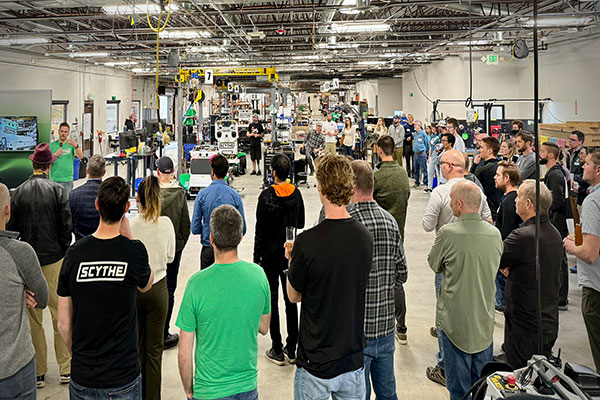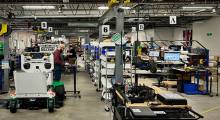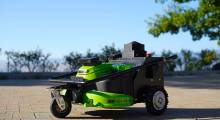Landscaping crews operate on the principle of efficiency. But monotonous mowing tasks take away from time that they can spend performing detail tasks, such as edging and trimming or managing planters.
Scythe Robotics developed its autonomous commercial mower, the M.52, to help landscapers improve their operational efficiency. With support from Scythe’s engineers, implementation team, and customer support services, landscapers can automate mowing large areas, gaining back time to complete detail work.
From machine testing to customer deployment training
Kali Hamilton, field robotics engineer at Scythe, said field service is primarily focused on the mechanical and electrical health of M.52 robots, but are also the first point of contact when something goes awry. “We need to be intimately familiar with all the ways an operator can misuse the robot.”
As the company’s first field hire, Hamilton started by fixing M.52 autonomous mobile robots (AMRs) in the production warehouse and supervised technicians. Over time, Hamilton became responsible for fleet management metrics, including availability and mean time between failures.
Mitigating issues starts with run-in testing. Once an M.52 mower rolls off the production line, Hamilton’s team performs hardware reliability testing to collect data and identify workmanship issues, such as cable routing that survived initial testing but did not hold up during run-in.
“We tend to catch those in run-in, in the first 20-25 hours of a robot’s life,” Hamilton said. “Then we consider robots deployable to customers.” Just before deployments, Hamilton’s team updates robots to the latest software, firmware, and engineering design changes.

Scythe deploys its M.52 mowers through a robotics-as-a-service (RaaS) model. Hamilton said Scythe’s implementation team works closely with customers to identify the best ways to incorporate autonomous mowers into landscaping teams and locate the best properties to use them at. The implementation team provides Scythe’s customers with an overview of how to use the M.52.
“We - from beginning to end - try and work on the landscape crew’s schedule,” said Billy Otteman, senior director of brand at Scythe. “We want to be as efficient as possible. We don't want to slow the crew down.”
Otteman said landscaping crews function like well-oiled machines, so Scythe’s integration team thinks carefully about how and where to train new operators. “We really have to be able to integrate our training into those days and into those executions,” he said. “We also want our training to be fast. We want our training to be intuitive and easy.”
“By the end of that first day, the customer loads the robots on their trailer, and our team drives off with an empty one,” Hamilton added.
Teaching landscapers strategies to manage fleets efficiently
Scythe’s implementation team trains landscapers how to use the M.52’s built-in Robot Control Panel (RCP). Through the RCP, operators can set mowers into one of four modes: park, neutral, drive, and Scythe. Before robots begin mowing autonomously in Scythe mode, they need to be told where to mow and where not to go. Operators use drive mode to generate that navigation information.
Hamilton said in drive mode, operators choose between manual mowing or zone creation. Before creating a zone, operators choose between creating a mow zone or a no-go zone. Operators can drive the robots around to map mow zone perimeters and larger or irregularly-shaped no-go zones, such as fenced areas. For smaller obstacles - including trees, poles, and large rocks - operators can drive the front of the mower up as close as possible and drop a location point onto the map, setting a radius for the no-go zone.
Hamilton said Scythe’s mowers are not currently set up for “swarm robotics,” or deploying multiple robots in the same mow zone simultaneously. But that doesn’t mean each robot runs in isolation. She said zone sharing allows an operator to use one robot to map and set up zones while a second operator moves additional mowers into each zone to start mowing.
“We're working towards more efficiency, and all the ways we can reduce touch points for operators when they're mowing with multiple robots,” Hamilton said.
Scythe’s M.52 mowers back up their zones to the cloud, but an on-robot planner performs navigation using Scythe’s software code base. When landscaping crews return to a customer location, they simply drive a robot back into the zone, and the RCP prompts them to either edit the task or start autonomous mowing. Operators can configure ground speed, blade speed, pattern, and other options, or reload a previous task with all its configurations.
“Every time those configurations change, the planner re-plans to maximize efficiency and also the type of plan to make sure our quality is good,” Hamilton said.

Because mow zones are simply the outline of an area, the M.52’s onboard planner can be instructed to change patterns through the RCP interface without having to remap zones. Hamilton said Scythe is currently focusing on providing a good cut quality for linear stripes, but also supports curves and may bring back spirals.
“Any changes to those configurations then become the most recent configurations for that task,” Hamilton said. “So it does allow crews to both edit in the moment, and also - if they've really nailed down on the configurations that they want for that mow zone - it is persistent both for that robot and across the fleet.”
Even though zones can be shared through the cloud, operators still need to evaluate dynamic conditions daily. Hamilton said Scythe’s implementation team trains landscape crews to configure the autonomous mowers for temporary changes, such as adding a no-go zone around a wet spot one day and removing it the next day.
“There can be some strategy around: do you do a no go zone, or do you create a mow zone that does not include this obstacle?” Hamilton said. “That can affect the plan efficiency pretty greatly.”
Customer training is all about efficiency - both learning how to use robot interfaces as well as maximizing the M.52’s capabilities. “For folks who aren’t used to autonomy or robotics, it does take several touch points for that to sink in,” she said.
“We'll often even mow alongside them the day of,” Hamilton added. “So that way you can hit the same property as you would have if we weren't here.”
Otteman said after shadowing landscaping crews, Scythe’s team follows up over the next few weeks to make sure they are using the mowers up to the level that they could be.
Camera data used to improve machine learning models
For localization to navigate through mow zones, the M.52 uses data from a real-time kinematic (RTK) positioning provider, which is received via antenna from a global navigation satellite system (GNSS). Cameras mounted around the robots provide 360 degrees of real-time obstacle detection.
Otteman said as Scythe’s camera-based machine vision gets more sophisticated, they can rely on it as a complementary data source when satellite coverage might be blocked, such as underneath a tree canopy. Hamilton and Otteman also said ultrasonic sensors are embedded in the M.52 frames for development of the next generation of mowers.
As Scythe’s robots autonomously mow, camera images are streamed for logging. Images are also collected from run-in, development, and test robots.
“We have an employee who somedays literally takes out the robot to various properties, just so we can make sure that we're capturing a variety of images, obstacles, dogs, trees, and brush,” Hamilton said.

Scythe’s data machine learning (ML) team works with a third party to categorize all the images to build AI training datasets. Otteman said obstacle images are prioritized based on frequency and importance. Humans, dogs, and trees are the most commonly encountered obstacles and the most important to avoid.
Otteman said the data ML team identifies where they need to increase the sophistication and breadth of the database as Scythe moves into new geographic markets.
Because M.52 robots are deployed across the U.S. - from Scythe’s Longmont, Colo. headquarters to Texas, Florida, and recently Ohio - the ML model has learned to differentiate similar items of the same class, such as grass and fire hydrants of different types and colors. “We have the largest database of landscape scenes of this kind that exists to our knowledge,” Otteman said.
Hamilton said the constant stream of data to improve ML models is incorporated in regular software releases. Part of her job is managing latency issues for software and firmware deployments.
“Part of field robotics that's exciting is when your robots aren't in a warehouse, and might be on a trailer or at the back of the shed,” Hamilton said. Scythe’s team must wait until customers finish mowing before sending updates. “We never want them to be surprised, and landscaping crews work on a pretty early schedule. So the field team - we have to be prepared to be up on their schedule as well.”
Otteman said the fleet management assigned to Hamilton’s team is more complex compared to warehouse and manufacturing applications.
“That kind of fleet management is one level of difficulty,” he said. “But then you add in the layers of being in a field, being a mobile robot, being a B2B [business-to-business] robot - trying to make sure you fit in this operational flow of a business and actually save them time - it’s just incredibly complex.”
The work that Kali and her team are doing is foundational to not just our success, but the success of our customers,” Otteman added.
Scythe app allows operators to interact with robots at a distance
Hamilton said when M.52 robots are unsure about what an obstacle is, they perform a safety stop. If the path ahead is clear, or the obstacle moves out of the way, operators can select a resume task option. The robots can pick up near where they left off or move over to the next stripe.
Operators can walk over to stopped robots and clear them through the RCP. But Hamilton also said operators can ping a customer support line, allowing them to keep working on their own tasks while Scythe’s team recovers stopped mowers.

Another interface option is Scythe’s mobile app, which provides the same functions as the RCP.
“The intent is to be able to do everything from the machine itself,” Otteman said, “so that an operator is not having to take their phone out in the field. They might be fumbling with work gloves, they might have dirt on their fingers, that kind of thing.
“However, we do also want the ability for an operator to interact with the machine from a distance,” Otteman added. “There's a few things that the mobile app just allows for better.”
Within the Scythe app, operators can see the location, status, and battery charge level of all robots assigned to their company. They can also see all the mow zones assigned to robots, and rename, reclassify, or regroup zones.
“This is visible on the robot control panel as well, but there's much more detail in the app since there's the ability to have more compute power and more functionality,” he said.
Otteman added Scythe is building functionality into its app to enable operators to check on the completion status of autonomous mowing jobs. This feature will provide landscapers with data that can allow them to plan their detail work around when the robots will finish their tasks.
Want to learn more about fleet management? This article was featured in the June 2024 Robotics 24/7 Special Focus Issue titled “Orchestrating mobile robot fleets for success.”
Forged in the Field
Scythe Robotics’ engineering team test their M.52 mower to its limitsAbout the Author
Follow Robotics 24/7 on Linkedin
Article topics
Email Sign Up


















